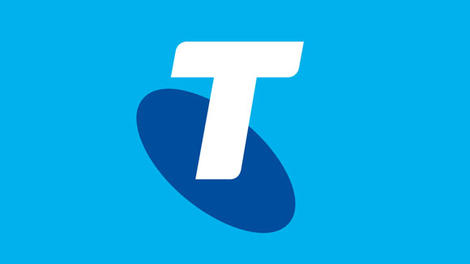When fully touch-centric smartphones suddenly exploded in popularity, BlackBerry wound up caught flat-footed. When the Waterloo company finally made the move to modernize years later, it couldn’t compete with the new heavyweights and disappointed old fans in the process. For a while there, it looked like BlackBerry couldn’t win.
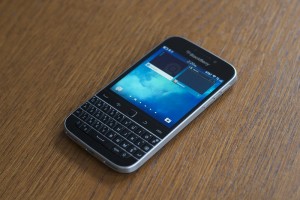
BlackBerry Classic
But the company’s once improbable comeback is inching along, and after last year’s Passport—a large and awkward, yet certainly interesting device—BlackBerry is back with the Classic. Quite obviously, in both name and design, it’s a return to its business-centric strengths. It echoes the familiar pocket-sized BlackBerry design of old, with the square screen above a physical keyboard, but with a sleek, refined finish.
It’s undoubtedly the finest traditional BlackBerry that the company has ever produced, but how does a top-level BlackBerry phone compare in this day and age? Can it really compete with the iPhone 6 and leading Android handsets? No, not in the slightest. But as a productivity machine, it has perks.
Build and Design
The BlackBerry Classic is one impressively built device. Upon picking it up, we immediately felt at least 20% more professional—it just has a premium air to it that feels wholly distinct from other modern smartphones. Actually using the device might not always fill you with such confidence, but the hardware itself is ace.
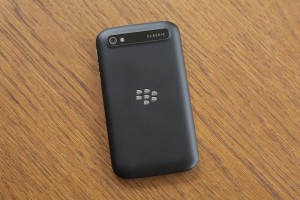
BlackBerry Classic back
What’s really striking is the heft of it: at 6.28oz, the Classic feels weighty and substantial, but that goes a long way toward selling the quality of the device. Like most phones on the market today, the latest BlackBerry has grown a bit since the Bold line, coming in at 5.16 inches tall, 2.85 inches wide, and a thickness of 0.4 inches. It’s still a little short and stout compared to the iPhone 6 or an Android flagship, but it looks a little heartier and more significant than previous models.
Naturally, the core point of focus on the BlackBerry Classic is its 35-button QWERTY keyboard, which retains the look and feel of past versions. The keys slope outwards from the center of the phone to guide your respective thumbs, with a big space bar below and a small resting space at the bottom. The BlackBerry Passport tried to shake things up by putting symbols and more on the touch screen, but the Classic keyboard lives up to its namesake, letting you tap “alt,” “sym,” or the shift arrow to modify text without leaving the keys.
No surprise: The keyboard feels great, and it’s the best you can get for a phone of this size—in part because there really aren’t competitors, but mainly because BlackBerry has spent ages refining this design. However, anyone who has spent years typing on touchscreens probably won’t see a speed increase here, at least not for some time. In our case, we’d get tripped up on a typo or try hunting for a symbol and find the process much slower than on Android or iOS. There’s a learning curve to using such a condensed, all-in-one keyboard; the short-term benefits aren’t very obvious.
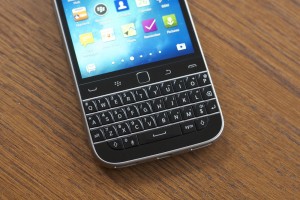
BlackBerry Classic keyboard
Above the keyboard are the familiar physical navigation buttons: one for initiating the calling app and another for settings on the left, along with the back button and exit app/end call button on the right. Dead center sits the trackpad, which serves as a tiny touch button for scrolling through menus and in some cases bringing up a small mouse pointer. With a touch display, this primarily seems like a way to appease fans of the older phones; it’s rarely faster to use that little nub than to just touch the icon or button you need.
On the right side of the phone are volume buttons, plus a smaller one between them that triggers BlackBerry Assistant. The power button and headphone jack are up top, you’ll find SIM and microSD card slots on the upper left, and the USB jack and solid-sounding speaker grates are on the bottom. A metal border helps define the premium aesthetic, but opinions may be mixed on the textured, rubberized backing, which is black with a metallic BlackBerry logo at center plus the camera panel near the top (along with the word “Classic”). We appreciate the grip and feel of it, although a metal or glass design might’ve been more appealing.
Display
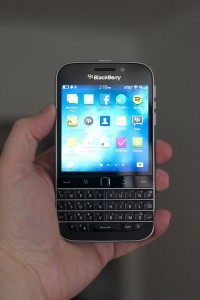
BlackBerry Classic
In a world of widescreen smartphone displays, the BlackBerry Classic sticks to its guns and presents another square screen. That’s a necessity with this form factor, due to the keyboard taking up most of the rest of the phone’s face, but it proves to be limiting in many respects.
At least it’s a solidly sharp screen: the 3.5-inch display runs at 720×720, or 294ppi, which isn’t as crisp (or as large, certainly) as the Passport, but it’s clear and colorful here. Strong contrast makes apps and media look bold and attractive, although the display could stand to be brighter. We had it at maximum brightness during most of our testing, and the way it automatically dims in darker scenarios made for some less-than-ideal evening moments.
As discussed in our Passport review last fall, the square screen is inconvenient for a lot of purposes. Most video media isn’t formatted in a 1:1 ratio, so 16:9 widescreen clips in particular leave a lot of blank space on a display like this. And while the OS is obviously designed for the dimensions, the poor third-party app support means some of the apps you’ll download from the Amazon Appstore either run with borders or appear scrunched on the screen. Again, when it comes to general, everyday use, the BlackBerry Classic has notable deficiencies.














-470-75.JPG)
